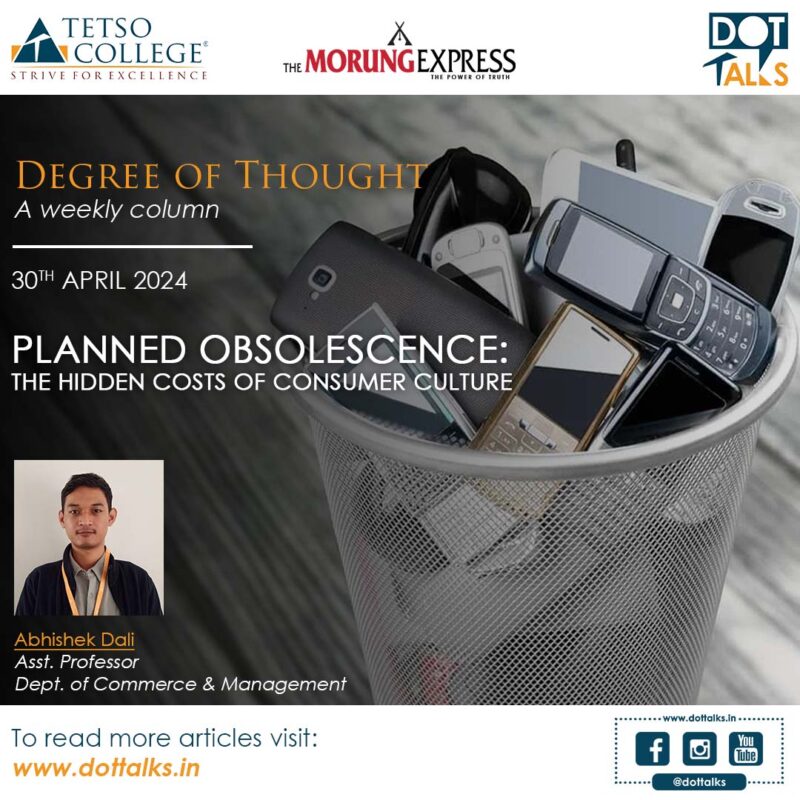
Planned Obsolescence: The Hidden Costs of Consumer Culture
Have you ever noticed your phone getting slow right before a new model is to be released? or maybe a perfectly functional printer suddenly refusing to recognise ink cartridges just as a new model hits the market? This is not necessarily a coincidence but a sinister concept of the corporations known as planned obsolescence.
Planned obsolescence is a prevalent strategy in the consumer market which involves intentionally designing products to have a short lifespan so that consumers would have to replace them frequently. Although this practice aims to boost sales, it raises ethical, environmental, and economic concerns. Planned obsolescence has significant detrimental environment effects including increased carbon emissions, waste generation, and resource depletion. Electronic waste, one direct result of this approach, poses risks to ecosystems and human health when not disposed of properly.
One of the earliest examples of planned obsolescence dates back to the 1920s when light bulb manufacturers deliberately reduced the lifespan of bulbs to encourage more frequent purchases. Since then, planned obsolescence has become widespread across various industries, including electronics, fashion, and automotive.
Planned obsolescence is deeply ingrained in our society and manifests in various forms, including functional obsolescence and stylistic obsolescence. Functional obsolescence occurs when products are designed to break down or become outdated after a certain period. This pushes consumers to upgrade unnecessarily. On the other hand, stylistic obsolescence involves deliberately designing products to appear outdated quickly, compelling consumers to follow ever-changing trends. These tactics not only impact consumer behavior but also have far-reaching consequences on the environment and the economy.
The environmental impact of planned obsolescence is a growing concern, as it contributes significantly to carbon emissions, waste production, and the exploitation of finite resources. The short lifespan of consumer goods poses challenges for waste management and recycling initiatives. Electronic waste, a result of discarded electronics contains hazardous materials and poses serious risks to ecosystems and human health when not properly handled. To address these environmental issues, a shift towards sustainable consumption practices that prioritize longevity, repairability, and resource efficiency is required.
Shortened product life spans contribute to a higher rate of disposal, leading to increased waste generation. Electronic waste, in particular, poses a significant challenge, as discarded electronics often contain hazardous materials that can leach into soil and water sources if not properly disposed of. According to the United Nations Environment Programme (UNEP), the world produces around 50 million tons of electronic waste annually, much of which ends up in landfills or is illegally exported to developing countries for disposal.
The fashion industry is another prominent example of planned obsolescence, with seasonal collections and rapidly changing trends encouraging consumers to regularly update their wardrobes. Fast fashion brands, in particular, produce clothing at a rapid pace, designed to be worn for a limited time before being replaced by the next trend. This cycle of constant consumption contributes to environmental degradation and exploitation of labor in garment-producing countries.
Furthermore, planned obsolescence extends beyond physical products to include software and digital content. Software updates and compatibility issues may render older devices obsolete, prompting consumers to purchase new hardware or subscribe to software services to access the latest features and security updates. Similarly, streaming platforms and digital media providers often restrict access to content through subscription models, leading consumers to continuously pay for access to a rotating catalog of movies, music, and television shows.
From an economic perspective, planned obsolescence has adverse effects on consumers and the economy as a whole. Constantly replacing products puts a pressure on household finances, particularly for low-income families, and encourages a culture of overconsumption and waste. This approach discourages innovation by prioritizing short-term profit over long-term sustainability. Instead of focusing on creating durable, high-quality products, companies allocate resources to frequent redesigns and marketing gimmicks, hindering technological advancement and progress towards a more sustainable future.
To combat the negative impacts of planned obsolescence, a multi-faceted approach is necessary. Governments, businesses, and consumers must collaborate to implement policies that regulate product durability, promote eco-design principles, and hold companies accountable for the entire lifecycle of their products. Transparent labeling schemes that inform consumers about a product’s durability and environmental impact empower them to make informed purchasing decisions.
As consumers, we have significant influence through our buying choices. By opting for products that prioritize quality, durability, repairability, and sustainability, we can send a clear message to manufacturers that planned obsolescence is unacceptable. Embracing practices such as repair, reuse, and second-hand shopping promotes a more circular and resource-efficient economy. By collectively rejecting the concept of planned obsolescence and advocating for sustainable consumption practices, we can drive meaningful change towards a more resilient and equitable society. It is time to redefine our relationship with consumer goods and embrace a future where durability, quality, and sustainability take precedence over short-term profits.
As awareness of these issues grows, consumers, activists, and policymakers are calling for greater transparency and accountability from manufacturers. Initiatives promoting repairability, durability, and circular economy principles are gaining momentum, offering alternatives to the wasteful practices associated with planned obsolescence. Ultimately, addressing planned obsolescence requires a shift in consumer behavior, industry practices, and regulatory frameworks toward more sustainable and ethical approaches to production and consumption.
In summary, planned obsolescence is a pervasive phenomenon with far-reaching consequences for the environment, consumers, and society as a whole. Addressing it requires a combination of regulatory action, consumer education, and technological innovation to promote more sustainable consumption patterns and reduce waste generation.
Degree of Thought is a weekly community column initiated by Tetso College in partnership with The Morung Express. Degree of Thought will delve into the social, cultural, political and educational issues around us. The views expressed here do not reflect the opinion of the institution. Tetso College is a NAAC Accredited UGC recognised Commerce and Arts College. The editorial team includes Chubamenla, Asst. Professor, Dept. of English and Rinsit Sareo, Asst. Manager, IT, Media & Communications.
For feedback or comments please email: dot@tetsocollege.org

